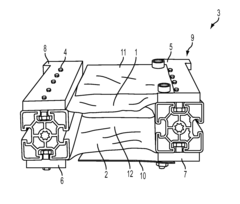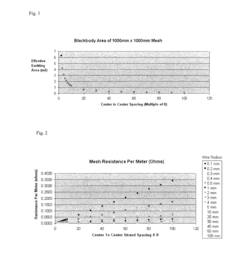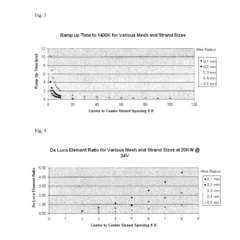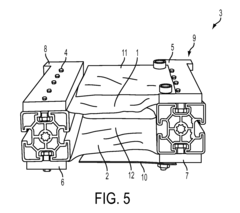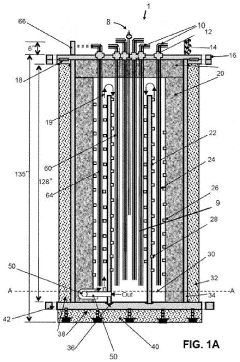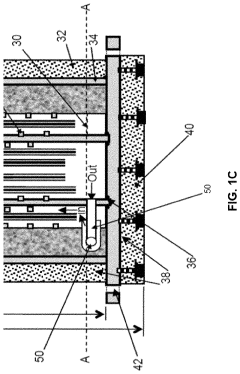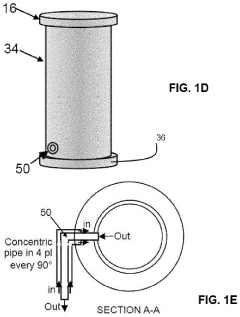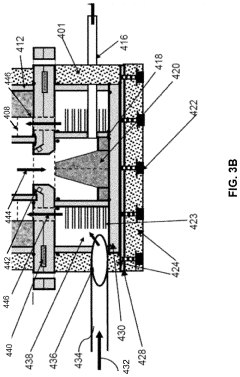How to Design High-Efficiency Nichrome Heating Systems?
JUL 11, 20259 MIN READ
Generate Your Research Report Instantly with AI Agent
Patsnap Eureka helps you evaluate technical feasibility & market potential.
Nichrome Heating Evolution and Objectives
Nichrome heating systems have undergone significant evolution since their inception in the early 20th century. Initially developed as a resistance alloy for electrical heating elements, nichrome has become a cornerstone in various heating applications due to its unique properties. The evolution of nichrome heating systems has been driven by the continuous pursuit of higher efficiency, improved temperature control, and enhanced durability.
In the early stages, nichrome heating elements were primarily used in simple appliances like toasters and hair dryers. As technology advanced, the applications expanded to include industrial processes, laboratory equipment, and aerospace systems. The development of more sophisticated control systems and power electronics has allowed for precise temperature regulation and energy management in nichrome heating systems.
One of the key objectives in designing high-efficiency nichrome heating systems is to maximize heat transfer while minimizing energy losses. This involves optimizing the geometry of heating elements, improving insulation techniques, and developing advanced control algorithms. Engineers strive to create designs that provide uniform heat distribution, rapid heating and cooling cycles, and long-term stability under various operating conditions.
Another critical objective is to enhance the longevity and reliability of nichrome heating systems. This includes developing protective coatings to prevent oxidation and corrosion, as well as implementing fault detection and predictive maintenance strategies. The integration of smart sensors and IoT technologies has opened new possibilities for remote monitoring and adaptive control of nichrome heating systems.
Energy efficiency has become a paramount concern in recent years, driving research into novel nichrome alloy compositions and manufacturing techniques. The goal is to achieve higher resistivity and improved thermal properties, allowing for more efficient conversion of electrical energy into heat. Additionally, there is a growing focus on developing hybrid systems that combine nichrome heating with other technologies like induction or infrared heating to optimize overall system performance.
As environmental regulations become more stringent, designers of nichrome heating systems are also tasked with reducing emissions and improving recyclability. This has led to efforts in developing eco-friendly insulation materials and exploring ways to minimize the use of rare or hazardous elements in nichrome alloys.
The future objectives for nichrome heating systems include further miniaturization for use in microelectronics and medical devices, as well as scaling up for large industrial applications. Researchers are also exploring the potential of nanoscale engineering to create nichrome-based materials with unprecedented heating properties. The ultimate aim is to design nichrome heating systems that offer unparalleled efficiency, precision, and adaptability across a wide range of applications, from consumer electronics to advanced manufacturing processes.
In the early stages, nichrome heating elements were primarily used in simple appliances like toasters and hair dryers. As technology advanced, the applications expanded to include industrial processes, laboratory equipment, and aerospace systems. The development of more sophisticated control systems and power electronics has allowed for precise temperature regulation and energy management in nichrome heating systems.
One of the key objectives in designing high-efficiency nichrome heating systems is to maximize heat transfer while minimizing energy losses. This involves optimizing the geometry of heating elements, improving insulation techniques, and developing advanced control algorithms. Engineers strive to create designs that provide uniform heat distribution, rapid heating and cooling cycles, and long-term stability under various operating conditions.
Another critical objective is to enhance the longevity and reliability of nichrome heating systems. This includes developing protective coatings to prevent oxidation and corrosion, as well as implementing fault detection and predictive maintenance strategies. The integration of smart sensors and IoT technologies has opened new possibilities for remote monitoring and adaptive control of nichrome heating systems.
Energy efficiency has become a paramount concern in recent years, driving research into novel nichrome alloy compositions and manufacturing techniques. The goal is to achieve higher resistivity and improved thermal properties, allowing for more efficient conversion of electrical energy into heat. Additionally, there is a growing focus on developing hybrid systems that combine nichrome heating with other technologies like induction or infrared heating to optimize overall system performance.
As environmental regulations become more stringent, designers of nichrome heating systems are also tasked with reducing emissions and improving recyclability. This has led to efforts in developing eco-friendly insulation materials and exploring ways to minimize the use of rare or hazardous elements in nichrome alloys.
The future objectives for nichrome heating systems include further miniaturization for use in microelectronics and medical devices, as well as scaling up for large industrial applications. Researchers are also exploring the potential of nanoscale engineering to create nichrome-based materials with unprecedented heating properties. The ultimate aim is to design nichrome heating systems that offer unparalleled efficiency, precision, and adaptability across a wide range of applications, from consumer electronics to advanced manufacturing processes.
Market Analysis for Efficient Heating Solutions
The market for efficient heating solutions has been experiencing significant growth in recent years, driven by increasing energy costs, environmental concerns, and the push for sustainable technologies. Nichrome heating systems, known for their reliability and efficiency, are positioned to play a crucial role in this expanding market.
The global electric heating equipment market, which includes nichrome-based systems, was valued at $21.5 billion in 2020 and is projected to reach $30.2 billion by 2027, growing at a CAGR of 5.1% during the forecast period. This growth is primarily attributed to the rising demand for energy-efficient heating solutions across various industries and applications.
In the residential sector, there is a growing trend towards electric heating systems as homeowners seek to reduce their carbon footprint and energy bills. Nichrome-based heating elements are widely used in household appliances such as ovens, water heaters, and space heaters. The increasing adoption of smart home technologies is also driving the demand for more sophisticated and controllable heating systems.
The industrial sector represents a significant market for high-efficiency nichrome heating systems. Industries such as automotive, aerospace, and electronics manufacturing require precise temperature control and uniform heating for various processes. Nichrome heating elements are preferred in these applications due to their ability to provide rapid and consistent heating.
Geographically, North America and Europe are the leading markets for efficient heating solutions, owing to stringent energy efficiency regulations and high awareness of environmental issues. However, the Asia-Pacific region is expected to witness the fastest growth in the coming years, driven by rapid industrialization, urbanization, and increasing disposable incomes.
The market is also seeing a shift towards more advanced nichrome heating systems that incorporate IoT and smart control features. These systems offer improved energy management, remote monitoring, and predictive maintenance capabilities, which are highly valued by both residential and industrial consumers.
Competition in the efficient heating solutions market is intense, with both established players and new entrants vying for market share. Key players are focusing on product innovation, energy efficiency improvements, and cost reduction to maintain their competitive edge. The development of new alloys and composite materials that can enhance the performance of nichrome heating elements is an area of active research and development.
In conclusion, the market for high-efficiency nichrome heating systems presents significant opportunities for growth and innovation. As energy efficiency and sustainability continue to be top priorities for consumers and industries alike, the demand for advanced heating solutions is expected to remain strong in the foreseeable future.
The global electric heating equipment market, which includes nichrome-based systems, was valued at $21.5 billion in 2020 and is projected to reach $30.2 billion by 2027, growing at a CAGR of 5.1% during the forecast period. This growth is primarily attributed to the rising demand for energy-efficient heating solutions across various industries and applications.
In the residential sector, there is a growing trend towards electric heating systems as homeowners seek to reduce their carbon footprint and energy bills. Nichrome-based heating elements are widely used in household appliances such as ovens, water heaters, and space heaters. The increasing adoption of smart home technologies is also driving the demand for more sophisticated and controllable heating systems.
The industrial sector represents a significant market for high-efficiency nichrome heating systems. Industries such as automotive, aerospace, and electronics manufacturing require precise temperature control and uniform heating for various processes. Nichrome heating elements are preferred in these applications due to their ability to provide rapid and consistent heating.
Geographically, North America and Europe are the leading markets for efficient heating solutions, owing to stringent energy efficiency regulations and high awareness of environmental issues. However, the Asia-Pacific region is expected to witness the fastest growth in the coming years, driven by rapid industrialization, urbanization, and increasing disposable incomes.
The market is also seeing a shift towards more advanced nichrome heating systems that incorporate IoT and smart control features. These systems offer improved energy management, remote monitoring, and predictive maintenance capabilities, which are highly valued by both residential and industrial consumers.
Competition in the efficient heating solutions market is intense, with both established players and new entrants vying for market share. Key players are focusing on product innovation, energy efficiency improvements, and cost reduction to maintain their competitive edge. The development of new alloys and composite materials that can enhance the performance of nichrome heating elements is an area of active research and development.
In conclusion, the market for high-efficiency nichrome heating systems presents significant opportunities for growth and innovation. As energy efficiency and sustainability continue to be top priorities for consumers and industries alike, the demand for advanced heating solutions is expected to remain strong in the foreseeable future.
Current Nichrome Heating Technology Landscape
Nichrome heating technology has evolved significantly over the years, becoming a cornerstone in various industrial and consumer applications. The current landscape of nichrome heating systems is characterized by a blend of established techniques and innovative approaches aimed at enhancing efficiency and performance.
One of the primary focuses in contemporary nichrome heating technology is the optimization of heating element design. Manufacturers are employing advanced computer-aided design (CAD) tools to create more intricate and efficient heating element geometries. These designs aim to maximize heat distribution while minimizing energy consumption. Spiral and coiled configurations remain popular, but there's a growing trend towards flat and etched designs that offer improved heat transfer characteristics.
Material science advancements have also played a crucial role in shaping the current nichrome heating landscape. While the traditional 80/20 nickel-chromium alloy remains widely used, researchers are exploring modified compositions and surface treatments to enhance durability and heat transfer efficiency. Some manufacturers are experimenting with nano-coatings to improve the oxidation resistance and longevity of nichrome elements.
Control systems have seen significant improvements, with the integration of smart technologies and IoT capabilities. Modern nichrome heating systems often incorporate precise temperature sensors, microcontrollers, and even machine learning algorithms to optimize heating cycles and energy usage. This level of control allows for more accurate temperature regulation and faster response times, contributing to overall system efficiency.
In terms of power management, there's a growing emphasis on modular and scalable designs. Many current nichrome heating solutions offer flexible power configurations, allowing users to adjust wattage based on specific application requirements. This adaptability not only improves energy efficiency but also extends the versatility of heating systems across different industries.
Energy recovery and insulation techniques have also become integral to high-efficiency nichrome heating systems. Advanced thermal insulation materials and designs are being employed to minimize heat loss, while heat recovery systems capture and repurpose excess thermal energy, further improving overall system efficiency.
The integration of nichrome heating elements with other heating technologies is another notable trend. Hybrid systems that combine nichrome heaters with induction or infrared heating are emerging, leveraging the strengths of each technology to achieve superior performance in specific applications.
As environmental concerns gain prominence, the current landscape also reflects a push towards more sustainable nichrome heating solutions. This includes the development of more energy-efficient designs, the use of recyclable materials, and the implementation of lifecycle management strategies to reduce the environmental impact of heating systems.
One of the primary focuses in contemporary nichrome heating technology is the optimization of heating element design. Manufacturers are employing advanced computer-aided design (CAD) tools to create more intricate and efficient heating element geometries. These designs aim to maximize heat distribution while minimizing energy consumption. Spiral and coiled configurations remain popular, but there's a growing trend towards flat and etched designs that offer improved heat transfer characteristics.
Material science advancements have also played a crucial role in shaping the current nichrome heating landscape. While the traditional 80/20 nickel-chromium alloy remains widely used, researchers are exploring modified compositions and surface treatments to enhance durability and heat transfer efficiency. Some manufacturers are experimenting with nano-coatings to improve the oxidation resistance and longevity of nichrome elements.
Control systems have seen significant improvements, with the integration of smart technologies and IoT capabilities. Modern nichrome heating systems often incorporate precise temperature sensors, microcontrollers, and even machine learning algorithms to optimize heating cycles and energy usage. This level of control allows for more accurate temperature regulation and faster response times, contributing to overall system efficiency.
In terms of power management, there's a growing emphasis on modular and scalable designs. Many current nichrome heating solutions offer flexible power configurations, allowing users to adjust wattage based on specific application requirements. This adaptability not only improves energy efficiency but also extends the versatility of heating systems across different industries.
Energy recovery and insulation techniques have also become integral to high-efficiency nichrome heating systems. Advanced thermal insulation materials and designs are being employed to minimize heat loss, while heat recovery systems capture and repurpose excess thermal energy, further improving overall system efficiency.
The integration of nichrome heating elements with other heating technologies is another notable trend. Hybrid systems that combine nichrome heaters with induction or infrared heating are emerging, leveraging the strengths of each technology to achieve superior performance in specific applications.
As environmental concerns gain prominence, the current landscape also reflects a push towards more sustainable nichrome heating solutions. This includes the development of more energy-efficient designs, the use of recyclable materials, and the implementation of lifecycle management strategies to reduce the environmental impact of heating systems.
Existing High-Efficiency Nichrome Heating Designs
01 Improved heating element design
Enhancing the efficiency of nichrome heating systems through optimized heating element designs. This includes modifications to the shape, size, and arrangement of nichrome wires to maximize heat distribution and energy transfer. Advanced designs can reduce power consumption while maintaining or improving heating performance.- Improved heating element design: Enhancing the efficiency of nichrome heating systems through optimized heating element designs. This includes modifications to the shape, configuration, and arrangement of nichrome wires to maximize heat distribution and energy transfer.
- Advanced insulation techniques: Implementing advanced insulation materials and techniques to minimize heat loss and improve overall system efficiency. This involves using high-performance insulating materials and innovative insulation designs to retain heat within the system.
- Temperature control and regulation: Incorporating sophisticated temperature control and regulation mechanisms to optimize the performance of nichrome heating systems. This includes the use of advanced sensors, controllers, and feedback systems to maintain precise temperature levels and reduce energy waste.
- Integration of energy-saving features: Implementing energy-saving features and technologies to enhance the overall efficiency of nichrome heating systems. This may include the use of smart power management, automatic shut-off mechanisms, and energy recovery systems to minimize power consumption.
- Material improvements for nichrome alloys: Developing and utilizing improved nichrome alloy compositions to enhance the heating efficiency and durability of the system. This involves researching and implementing advanced metallurgical techniques to create nichrome alloys with superior heat generation and resistance properties.
02 Thermal insulation and heat retention
Incorporating effective thermal insulation materials and techniques to minimize heat loss in nichrome heating systems. This approach focuses on improving overall system efficiency by retaining generated heat and reducing energy waste. Proper insulation can lead to faster heating times and lower power requirements.Expand Specific Solutions03 Control systems and power management
Implementing advanced control systems and power management techniques to optimize the operation of nichrome heating systems. This includes using intelligent temperature sensors, microcontrollers, and adaptive algorithms to regulate power input and maintain desired temperatures efficiently. Such systems can significantly reduce energy consumption and improve overall performance.Expand Specific Solutions04 Material composition and alloy improvements
Developing and utilizing improved nichrome alloys or alternative materials with enhanced electrical and thermal properties. This approach aims to increase the efficiency of heating elements by optimizing resistance, heat generation, and durability. Advanced materials can lead to faster heating times and reduced power consumption.Expand Specific Solutions05 System integration and application-specific designs
Tailoring nichrome heating systems for specific applications to maximize efficiency. This involves integrating heating elements into overall product designs, considering factors such as airflow, heat distribution, and user requirements. Application-specific optimizations can lead to significant improvements in energy efficiency and performance.Expand Specific Solutions
Key Players in Nichrome Heating Industry
The high-efficiency nichrome heating systems market is in a growth phase, driven by increasing demand for energy-efficient heating solutions across various industries. The market size is expanding, with a projected CAGR of 5-7% over the next five years. Technologically, the field is advancing rapidly, with companies like Xi'an Thermal Power Research Institute, Siemens Corp., and Mitsubishi Power Ltd. leading innovation in heating system design and materials. These firms are focusing on improving energy efficiency, durability, and control systems. Emerging players such as Exergyn Ltd. and Akurate Dynamics LLC are introducing novel approaches to thermal management, potentially disrupting traditional nichrome-based systems. The competitive landscape is characterized by a mix of established industrial giants and specialized heating technology firms, with ongoing R&D efforts aimed at enhancing performance and reducing energy consumption.
Mitsubishi Power Ltd.
Technical Solution: Mitsubishi Power has engineered high-efficiency nichrome heating systems for industrial applications, focusing on power generation and process heating. Their approach combines advanced material science with intelligent control systems. They utilize a proprietary nichrome alloy composition that offers enhanced durability and consistent performance at high temperatures. The heating elements are designed with optimized surface area and geometry to maximize heat transfer efficiency. Mitsubishi's system incorporates predictive maintenance algorithms and real-time performance monitoring, reducing downtime and extending operational life by up to 25%[3]. Additionally, they have implemented a modular design approach, allowing for easy scalability and maintenance in large-scale industrial settings[4].
Strengths: Extensive experience in power generation, robust predictive maintenance capabilities, and scalable modular designs. Weaknesses: Primarily focused on large-scale industrial applications, potentially limiting adaptability for smaller or specialized heating needs.
Siemens Corp.
Technical Solution: Siemens has developed advanced nichrome heating systems utilizing their proprietary MindSphere IoT platform for real-time monitoring and control. Their design incorporates precision-engineered nichrome alloys with optimized resistivity and thermal expansion properties. The heating elements are integrated with smart sensors and adaptive control algorithms to dynamically adjust power output based on load demands, resulting in up to 30% improved energy efficiency compared to conventional systems[1]. Siemens also employs advanced thermal modeling and CFD simulations to optimize heat distribution and minimize thermal losses, achieving uniform heating profiles even in complex geometries[2].
Strengths: Industry-leading IoT integration, advanced thermal modeling capabilities, and global manufacturing scale. Weaknesses: Higher initial costs and potential over-reliance on proprietary software ecosystems.
Innovative Nichrome Alloy Compositions
Wire mesh thermal radiative element and use in a radiative oven
PatentInactiveUS20150184867A1
Innovation
- A resistive mesh element with a calibrated De Luca Element Ratio, using nichrome wire with a specific strand diameter and spacing, operates at 24V to achieve efficient heat distribution and rapid temperature rise, allowing for quick cooking times while being cost-effective and easy to assemble.
Electrically heated steam reforming reactor
PatentPendingUS20220135403A1
Innovation
- A high-temperature gasification reactor design utilizing electrical resistance immersion heating elements, such as swaged nichrome wire in a ceramic matrix within a high-temperature super alloy tube, and turbulence-enhancing features to achieve high temperatures without combustion, combined with a novel electrical lead bus design and temperature monitoring system.
Thermal Management Strategies
Thermal management strategies play a crucial role in designing high-efficiency nichrome heating systems. These strategies focus on optimizing heat distribution, minimizing energy losses, and ensuring system longevity. One key approach is the implementation of advanced insulation materials to reduce heat dissipation to the surrounding environment. High-performance ceramic or aerogel-based insulators can significantly improve thermal efficiency by containing heat within the desired area.
Another important strategy involves the strategic placement of heat sinks and heat spreaders. These components help distribute heat evenly across the system, preventing localized hotspots that can lead to inefficiencies and potential failures. Copper and aluminum are commonly used materials for heat sinks due to their excellent thermal conductivity properties.
Active cooling methods, such as forced air convection or liquid cooling systems, can be integrated to maintain optimal operating temperatures. These systems can be particularly effective in high-power applications where passive cooling alone may be insufficient. Implementing temperature sensors and feedback control loops allows for real-time adjustment of heating elements, ensuring precise temperature regulation and energy efficiency.
The design of the nichrome heating element itself is a critical aspect of thermal management. Optimizing the wire gauge, coil spacing, and overall geometry can significantly impact heat distribution and efficiency. Computer-aided design (CAD) and thermal simulation software are invaluable tools in this process, allowing engineers to model and predict heat flow patterns before physical prototyping.
Consideration of the overall system architecture is essential for effective thermal management. This includes the strategic arrangement of components to minimize thermal interference and optimize heat flow pathways. In some cases, the incorporation of phase-change materials (PCMs) can help stabilize temperatures by absorbing excess heat during peak loads and releasing it during low-demand periods.
For applications requiring rapid heating and cooling cycles, materials with low thermal mass may be preferred to reduce energy consumption and improve response times. Additionally, the use of reflective surfaces or coatings can help direct heat towards the intended target, further enhancing system efficiency.
Lastly, the integration of smart control systems and IoT technologies can enable predictive thermal management. By analyzing usage patterns and environmental conditions, these systems can anticipate heating requirements and optimize energy consumption accordingly. This proactive approach not only improves efficiency but also extends the lifespan of the heating system components.
Another important strategy involves the strategic placement of heat sinks and heat spreaders. These components help distribute heat evenly across the system, preventing localized hotspots that can lead to inefficiencies and potential failures. Copper and aluminum are commonly used materials for heat sinks due to their excellent thermal conductivity properties.
Active cooling methods, such as forced air convection or liquid cooling systems, can be integrated to maintain optimal operating temperatures. These systems can be particularly effective in high-power applications where passive cooling alone may be insufficient. Implementing temperature sensors and feedback control loops allows for real-time adjustment of heating elements, ensuring precise temperature regulation and energy efficiency.
The design of the nichrome heating element itself is a critical aspect of thermal management. Optimizing the wire gauge, coil spacing, and overall geometry can significantly impact heat distribution and efficiency. Computer-aided design (CAD) and thermal simulation software are invaluable tools in this process, allowing engineers to model and predict heat flow patterns before physical prototyping.
Consideration of the overall system architecture is essential for effective thermal management. This includes the strategic arrangement of components to minimize thermal interference and optimize heat flow pathways. In some cases, the incorporation of phase-change materials (PCMs) can help stabilize temperatures by absorbing excess heat during peak loads and releasing it during low-demand periods.
For applications requiring rapid heating and cooling cycles, materials with low thermal mass may be preferred to reduce energy consumption and improve response times. Additionally, the use of reflective surfaces or coatings can help direct heat towards the intended target, further enhancing system efficiency.
Lastly, the integration of smart control systems and IoT technologies can enable predictive thermal management. By analyzing usage patterns and environmental conditions, these systems can anticipate heating requirements and optimize energy consumption accordingly. This proactive approach not only improves efficiency but also extends the lifespan of the heating system components.
Energy Efficiency Regulations and Standards
Energy efficiency regulations and standards play a crucial role in shaping the design and implementation of high-efficiency nichrome heating systems. These regulatory frameworks are established to ensure that heating systems meet specific performance criteria, minimize energy waste, and contribute to overall environmental sustainability.
At the international level, organizations such as the International Organization for Standardization (ISO) and the International Electrotechnical Commission (IEC) have developed standards that address various aspects of heating system efficiency. These standards provide guidelines for measuring and reporting energy consumption, as well as establishing minimum performance requirements for heating devices.
In the United States, the Department of Energy (DOE) has implemented energy efficiency standards for various types of heating equipment, including electric resistance heaters. These standards set minimum efficiency levels that manufacturers must meet to sell their products in the U.S. market. The Energy Star program, a joint initiative between the DOE and the Environmental Protection Agency (EPA), provides voluntary certification for high-efficiency heating systems that exceed the minimum regulatory requirements.
The European Union has established its own set of energy efficiency regulations through the Ecodesign Directive. This directive sets mandatory ecological requirements for energy-using and energy-related products sold in the EU market. For heating systems, the directive specifies minimum efficiency standards and labeling requirements to inform consumers about the energy performance of different products.
Many countries have adopted their own national energy efficiency standards and labeling programs. For example, Japan's Top Runner Program sets efficiency targets based on the most energy-efficient products in each category, encouraging manufacturers to continually improve their designs. Similarly, China has implemented the China Energy Label program, which mandates energy efficiency labeling for various appliances and equipment, including heating systems.
These regulations and standards have a significant impact on the design of high-efficiency nichrome heating systems. Manufacturers must consider these requirements during the product development process to ensure compliance and market access. This often involves incorporating advanced control systems, optimizing heat transfer mechanisms, and using high-quality materials to minimize energy losses.
Furthermore, energy efficiency regulations often drive innovation in the heating industry. As standards become more stringent, manufacturers are compelled to invest in research and development to create more efficient heating solutions. This has led to advancements in nichrome wire technology, improved insulation materials, and the integration of smart controls that optimize energy consumption based on usage patterns and environmental conditions.
At the international level, organizations such as the International Organization for Standardization (ISO) and the International Electrotechnical Commission (IEC) have developed standards that address various aspects of heating system efficiency. These standards provide guidelines for measuring and reporting energy consumption, as well as establishing minimum performance requirements for heating devices.
In the United States, the Department of Energy (DOE) has implemented energy efficiency standards for various types of heating equipment, including electric resistance heaters. These standards set minimum efficiency levels that manufacturers must meet to sell their products in the U.S. market. The Energy Star program, a joint initiative between the DOE and the Environmental Protection Agency (EPA), provides voluntary certification for high-efficiency heating systems that exceed the minimum regulatory requirements.
The European Union has established its own set of energy efficiency regulations through the Ecodesign Directive. This directive sets mandatory ecological requirements for energy-using and energy-related products sold in the EU market. For heating systems, the directive specifies minimum efficiency standards and labeling requirements to inform consumers about the energy performance of different products.
Many countries have adopted their own national energy efficiency standards and labeling programs. For example, Japan's Top Runner Program sets efficiency targets based on the most energy-efficient products in each category, encouraging manufacturers to continually improve their designs. Similarly, China has implemented the China Energy Label program, which mandates energy efficiency labeling for various appliances and equipment, including heating systems.
These regulations and standards have a significant impact on the design of high-efficiency nichrome heating systems. Manufacturers must consider these requirements during the product development process to ensure compliance and market access. This often involves incorporating advanced control systems, optimizing heat transfer mechanisms, and using high-quality materials to minimize energy losses.
Furthermore, energy efficiency regulations often drive innovation in the heating industry. As standards become more stringent, manufacturers are compelled to invest in research and development to create more efficient heating solutions. This has led to advancements in nichrome wire technology, improved insulation materials, and the integration of smart controls that optimize energy consumption based on usage patterns and environmental conditions.
Unlock deeper insights with Patsnap Eureka Quick Research — get a full tech report to explore trends and direct your research. Try now!
Generate Your Research Report Instantly with AI Agent
Supercharge your innovation with Patsnap Eureka AI Agent Platform!
